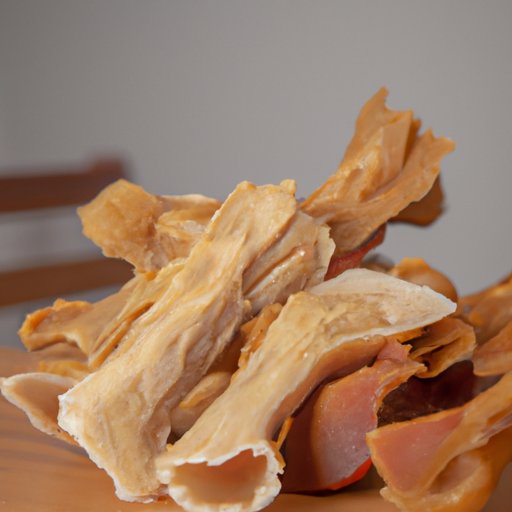Introduction
Tripe is an increasingly popular food option for dogs, but many pet owners don’t know exactly what it is or how it can benefit their pet. In this article, we will explore what tripe for dogs is, as well as the benefits and drawbacks of feeding it to your pup. We will also provide a detailed guide on how to choose, prepare, and serve tripe for your dog.
What is Tripe and How Can It Benefit Your Dog?
Tripe is the stomach lining of a cow, sheep, or other ruminant animal. It is usually sold raw or lightly cooked and is high in protein, minerals, and vitamins. According to Dr. Jennifer Coates, DVM and advisor for PetMD, “Tripe contains a variety of vitamins, minerals and fatty acids that are essential for overall health.”
Nutritional Value of Tripe for Dogs
Tripe is a good source of protein, which is important for building and maintaining muscle mass. It is also rich in essential fatty acids such as omega-3s and omega-6s, which can help to keep your dog’s coat healthy and shiny. Additionally, tripe is packed with vitamins and minerals such as calcium, phosphorus, zinc, and B-vitamins.
Pros of Feeding Tripe to Your Dog
Feeding tripe to your dog has a number of benefits. For one, it is a great source of protein and essential nutrients, making it a nutritious addition to your pup’s diet. Tripe is also highly palatable, so it can be a great way to get picky eaters to enjoy mealtime. Finally, tripe is relatively inexpensive compared to other types of dog food, so it can be a cost-effective option for pet owners on a budget.
Cons of Feeding Tripe to Your Dog
There are a few potential drawbacks to feeding tripe to your dog. Firstly, tripe is not a complete and balanced diet, so it should not be fed as a sole source of nutrition. Additionally, tripe can contain harmful bacteria if not properly handled and cooked, which can make your dog sick. Finally, tripe may not be suitable for dogs with allergies or sensitivities, so it’s important to consult with your veterinarian before adding it to your pup’s diet.
A Detailed Guide to Tripe for Dogs
Now that you know more about the potential benefits and risks of feeding tripe to your dog, let’s take a look at how to choose, prepare, and serve it. Here is a step-by-step guide to ensure that your pup gets all the nutrition and flavor from tripe without any of the risks.
How to Choose the Right Type of Tripe
When choosing tripe for your pup, it’s important to select a product that is of good quality. Look for tripe that is labeled “green” or “unbleached”, as these types are less likely to contain harmful bacteria. You should also check the label for any added preservatives or fillers, as these can be unhealthy for your pup.
Preparing Tripe for Your Dog
Once you have chosen the right type of tripe for your pup, it’s time to prepare it. If you are using raw tripe, it’s important to thoroughly wash it before serving to remove any potential contaminants. Additionally, you should cook the tripe until it is fully cooked through to reduce the risk of bacterial contamination. Boiling, steaming, or baking are all good methods for preparing tripe for your pup.
Different Ways to Serve Tripe to Your Dog
Once the tripe is prepared, there are a few different ways to serve it to your pup. You can mix it into their regular kibble or wet food, or serve it as a treat or snack. You can also use it as a topping for homemade dog treats or freeze it into cubes for a cool treat on hot days. However you decide to serve it, make sure to monitor your pup while they are eating to ensure they don’t choke or swallow large pieces.
Is Tripe Good for Dogs? Pros and Cons
In conclusion, tripe can be a great addition to your pup’s diet. Not only is it a good source of protein and essential nutrients, but it is also highly palatable and relatively inexpensive. However, it is important to remember that tripe is not a complete and balanced diet, and it can contain harmful bacteria if not properly handled and cooked. Therefore, it is important to consult with your veterinarian before adding tripe to your pup’s diet and to follow proper food safety guidelines when handling and preparing it.
Conclusion
Overall, tripe can be a beneficial addition to your pup’s diet. It is packed with protein and essential nutrients, and it is relatively inexpensive compared to other types of dog food. However, it is important to remember that tripe is not a complete and balanced diet, and it can contain harmful bacteria if not properly handled and cooked. As long as you follow proper food safety guidelines and consult with your veterinarian before feeding tripe to your pup, it can be a great way to boost their nutrition and add variety to their meals.
(Note: Is this article not meeting your expectations? Do you have knowledge or insights to share? Unlock new opportunities and expand your reach by joining our authors team. Click Registration to join us and share your expertise with our readers.)
